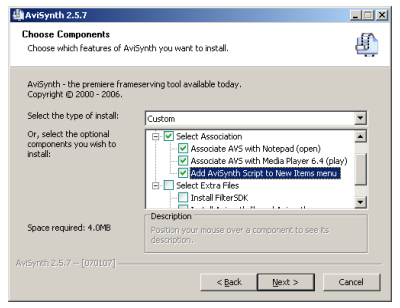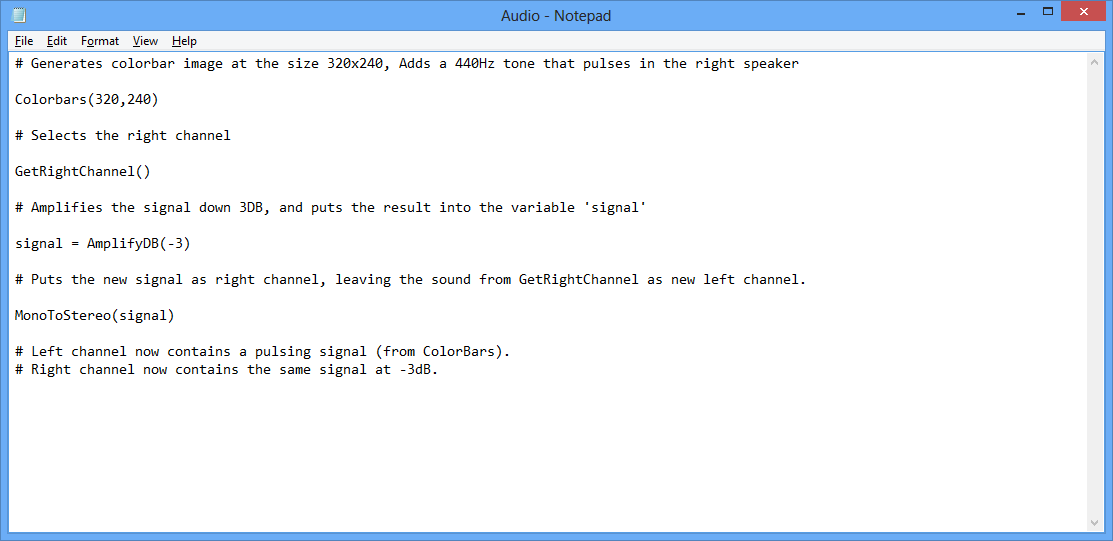

- #AVISYNTH 2.5 7 DOWNLOAD HOW TO#
- #AVISYNTH 2.5 7 DOWNLOAD INSTALL#
- #AVISYNTH 2.5 7 DOWNLOAD ZIP FILE#
- #AVISYNTH 2.5 7 DOWNLOAD DOWNLOAD#
and put the contents in your Avisynth plugins folder and windows ssytem folder as per the instructions within the plugins download.

#AVISYNTH 2.5 7 DOWNLOAD DOWNLOAD#
Next download ffmpegsource2 plugin beta version r578.7z to decode your MTS files. avsi etc are copied directly in to the avisynth plugins folder rather than sub folders. Unzip them into your Avisynth plugins directory inside your Avisynth folder wherever that was installed.
#AVISYNTH 2.5 7 DOWNLOAD INSTALL#
You already have Virtualdub installed, next install Avisynth 2.5.8.ĭownload the QTGMC stuff here that is the QTGMC script and the plugins pack. This may help with some of the other errors.Ok, I’ve always used a deinterlacing plugin for Avisynth called TempGaussBeta2, it was slow but good quality, it’s been updated regularly for over a year now. Also, I added a colorspace conversion on the AVISource line. This will run more slowly (I get about 20 fps instead of 90 fps on my computer), but it should eliminate all the other issues. Not needed for digital sources (like DV)chroma=source.Cnr2("oxx",8,16,191,100,255,32,255,false) #VHS#chroma=source.Cnr2("oxx",8,14,191,75,255,20,255,false) #Laserdisc #This next line calls the actual noise reduction function#Change the overlap paramater (the first "0" in the line below) to 0, 1, 2, 3, or 4#to get different reduction characteristics.#Change the second "0" to "1" if you want to remove flicker in videooutput=MDegrain2i2(chroma,0,0)#This next line can be uncommented if you want to compare before and after#If you remove the comment, comment out the return output line below it.#stackhorizontal(source,output)return output#The following is the function which actually performs the noise reduction.function MDegrain2i2(clip source, int "overlap", int "dct") #Denoiser script for interlaced videoLoadplugin("C:\Program Files\AviSynth 2.5\plugins\mvtools2.dll")loadPlugin("c:\Program Files\AviSynth 2.5\plugins\Cnr2.dll")loadPlugin("c:\Program Files\AviSynth 2.5\plugins\MT.dll")#The following line sets the simplest multi-threading modeSetMTMode(5)#Modify this line to point to your video filesource=AVISource("E:\Disney Films\Winning Inline Hockey0001.avi")#The following line sets a faster multi-threading modeSetMTMode(2,0)#CNR reduces VHS chroma noise. If you prefer to edit and render in Vegas, you can open the AVS file in VFAPIConv and then save the result to a signpost AVI file (this takes a few minutes for a two hour file). Open the AVS script in VirtualDub and edit and save the results. In the AVISource line in the script, replace the video file name with the path and name of the video file you want to improve.ħ. Copy the script below to Notepad and save it with the extension "AVS."Ħ.
#AVISYNTH 2.5 7 DOWNLOAD ZIP FILE#
Once renamed, copy the "special" AVISynth.DLL file contained in the MT zip file to the SYSTEM32 folderĥ. Then, go to the C:\WINDOWS\SYSTEM32 folder and rename the AVISynth.DLL file. This provides multi-threading capability to AVISynth. Put the MVTools2 DLL in the AVISynth plugin folder (make sure it is MVTools2.DLL and not MVTools.DLL: you want the one with the "2" at the end).Ĥ. Interlaced is harder to do correctly which is why I am posting that.ģ. It can easily be adapted to HD and/or progressive. Here's the "recipe" for cleaning interlaced SD video. If that isn't your cup of tea, you don't need to read any further. On my computer (a 3.2 GHz i7), I can clean SD interlaced video at 3x real time.Īnyone who uses Neat Video should be impressed with that. This new technique not only produces amazingly good quality, but it is also MUCH faster than anything I have used previously. I wanted to share my latest technique which is significantly superior to both Neat Video and to fft3dfilter (an AVISynth plugin). I guess all of us have experienced this feeling as digital video technology has progressed. The original technology I used then seems pretty crude now.

#AVISYNTH 2.5 7 DOWNLOAD HOW TO#
Back in early 2003 I first posted about how to reduce chroma and luma noise in VHS video captures.



 0 kommentar(er)
0 kommentar(er)
